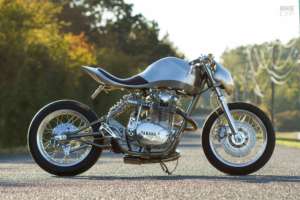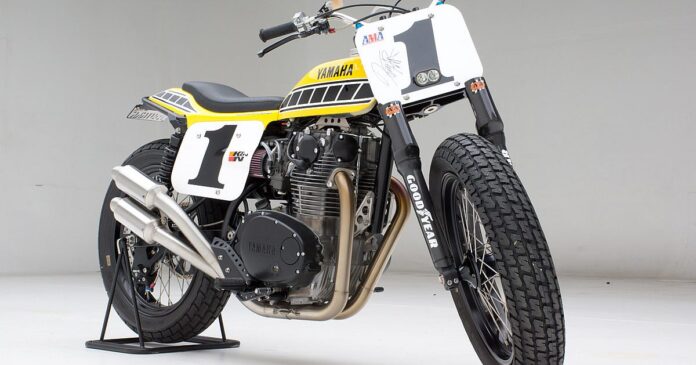Some bikes are just born to be customized, and few have stepped up to the blank-canvas challenge quite like Yamaha’s XS650. It’s got a bulletproof motor, timeless lines, and a massive following—the perfect recipe for custom greatness.
The heart of the beast was its 654cc air-cooled, SOHC parallel twin engine. Critically, the engine and gearbox were of unit construction with a horizontally split crankcase. This advanced design was a game-changer, giving it a reputation for reliability and, crucially, a near-total absence of the annoying oil leaks that plagued the British bikes of the era.
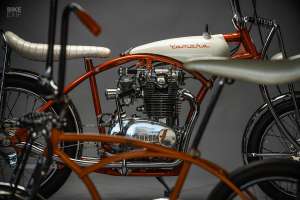
Evolution was quick, with the original kick-start only models giving way to the 1972 XS-2, which wisely added an electric starter and a front disc brake—a huge step up in daily usability. Later in 1978, the market demanded a different look, and Yamaha delivered with the “Special” cruiser model, complete with a teardrop tank and pull-back bars, which proved immensely popular, particularly in the United States.
Beyond the showroom, the XS650 engine became an icon in American dirt track racing. This trusty parallel twin shattered the long-standing dominance of Harley-Davidson, powering the bikes of future champions like Kenny Roberts, Wayne Rainey, and Eddie Lawson early in their careers.

Though the Standard model was discontinued around 1979, the cruiser-style Special variants were produced until 1985 (ending in 1983 in the U.S.), cementing its legacy. Today, the XS650 is celebrated for its simplicity and rugged durability, making it one of the most popular vintage platforms for custom builders of every stripe.
From hyper-minimalist bobbers to neo-futuristic café racers, the range of what this platform can achieve is staggering. Here are seven of our favorite customized XS650s that have graced Bike EXIF over the years.
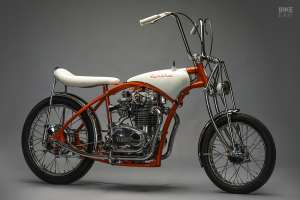
MotoRelic’s Schwinn-inspired Yamaha XS650
Sean Skinner at MotoRelic usually has a knack for creating tidy restomods, but he threw Bike EXIF a major curveball with this project: a vintage Schwinn-inspired Yamaha XS650. The offbeat idea was to build an upsized, motorcycle-powered replica of the famed 1968 Stingray Orange Krate bicycle. The biggest challenge was replicating the swooping, tubular curves of the Stingray’s frame, a task that required cutting and modifying a stock neck and shaping every other steel tube from scratch.
The frame sat stalled for four years until Sean found the perfect component to re-ignite the build: an XS650 mill that had been extensively ‘re-phased’ by Hugh’s Hand Built. With the engine sorted, Sean got the proportions right by lacing a comically large 21-inch rim to the rear hub, which helped set the ride height for the bike’s signature feature: the ‘banana girder’ front end. This assembly was custom-made, using an adjustable mountain bike shock for compliance and a hacked-up set of ape hangers for the final cockpit look.

The details are as whimsical as the concept. Sean modified a Yamaha Virago fuel tank to fit the Stingray’s lines and hold a usable amount of gas. He also custom-built the classic banana seat and was adamant about replicating the Stingray’s signature seat shocks at the base of the sissy bar, machining all the parts to create a full-sized version. Finished in a dazzling candy orange frame, heavy flake off-white paint, and retro-fabulous white glitter vinyl on the seat, this is a fun, whimsical build—pure art in motion and a childhood memory brought to life. [MORE]
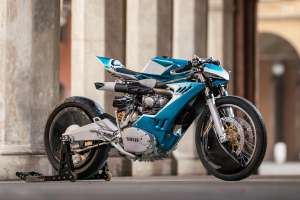
Simone Conti’s Aluminum Skinned XS650
Calling this a custom XS650 is a bit of a stretch, because the only original parts left are the engine, transmission, wheels, and rear brake. Determined to prove his friends wrong, Simone Conti set out to build one of his wildest motorcycles yet. The true magic lies in the chassis: the twin-cylinder mill no longer sits in its original steel frame; instead, it’s suspended from a full aluminum setup, designed and fabricated entirely by Simone himself.
This new chassis is a modular design, using tubular sections for the front and subframe, tied together with precision CNC-cut mounting plates. The boxy swingarm is also a custom piece, hooked up to an Öhlins shock. Up front, the suspension and brakes are heavily upgraded with Honda CBR600RR forks and Brembo twin brake calipers, mixing a futuristic vibe with classic Avon and Dunlop tires.
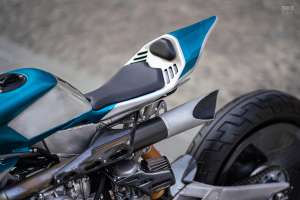
Metal shaping is Simone’s forte, and this XS650 is swathed in handmade aluminum parts. The aesthetic is lithe and muscular, evoking images of jet fighters and anime mechs. From the sculpted fuel tank to the waspish tail section, every piece is heavily detailed with sharp edges and visible welds. The practicality is baked in, too, with quarter-turn fasteners on the fairing making servicing a breeze. Simone even collaborated with friends to reproduce several parts—like the vented front brake scoops and wheel covers. The result is a neo-futuristic café racer that is nothing short of spectacular. [MORE]
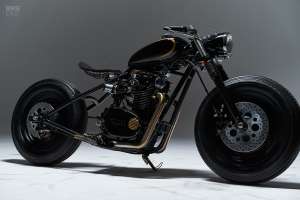
Eastern Spirit Garage’s XS650 Bobber
Eastern Spirit Garage has firmly established itself as a master of the classic café racer genre, but shop boss Sylwester likes to occasionally break the mold as they did with this perfectly proportioned bobber. It’s based on an early 80s Yamaha XS650 Special, which, as Sylwester notes, was a perfect, affordable base that wasn’t too “painful to cut down.”
The crew started by stripping the bike down, removing the rear of the frame, and fabricating their own hardtail setup. The handmade floating seat is a masterpiece of engineering, featuring an incredibly elegant and surprisingly comfortable suspension system that employs a mountain bike shock. They further perfected the stance by modifying the head angle with custom-built offset yokes, shortening the forks, and updating the wheels for solid aftermarket 16-inch units intended for a Harley-Davidson Fat Boy.
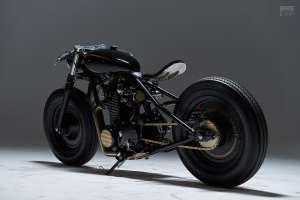
Custom touches are everywhere, including clip-ons, rear-sets, and a svelte new exhaust system with hidden silencers. Under the moody black and gold-plated exterior, the motor received a proper rebuild with new internals.
The final color scheme is classic gloss black with a subtle double gold pin stripe, rewarding closer inspection with a plethora of small details, such as the drilled-out brake discs and rear turn signals cleverly integrated into the frame. Sylwester’s sharp eye for silhouette is evident, resulting in a slick bobber that doesn’t scream for attention but rewards it handsomely. [MORE]
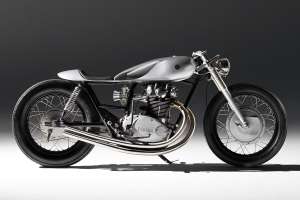
Auto Fabrica’s ‘Type 6’
In Japan, there is a design theory called Kanso (簡素), meaning simplicity, or the elimination of clutter. Every time a machine rolls out of Auto Fabrica’s English workshop, it is a masterclass in that fine principle.
Shop owner Bujar Muharremi and his crew strive for “simplicity in form, complexity in detail,” spending an enormous amount of time on preliminary design before even touching a grinder. The resulting aesthetic is one of almost impossible cleanliness, largely due to the single, elegant unit of the tank and seat base, formed from 2.5-millimeter aluminum. The frame itself was modified by lowering and slightly moving back the headstock to create a strong top line that flows uninterrupted from the headlight to the rear cowl.
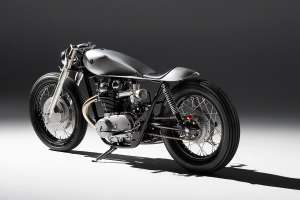
Inspired by other great builds, Auto Fabrica used a single carb conversion, continuing the line of the handmade stainless steel exhaust all the way through to the filter for an asymmetric visual balance that works beautifully. The exhaust pipes are unmuffled, but they have custom baffles hidden inside to provide a refined exhaust note. Up front, a beautiful Laverda SF750 twin leading shoe hub is laced to a 19-inch rim, and the cockpit is kept sleek with slim clip-ons and a custom wrap that conceals the controls in a smooth loop. [MORE]
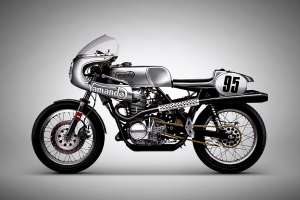
Brad Monk’s Yamando Racer
Brad Monk is a racer, and this is his weapon of choice: a ‘Yamando’—part Yamaha XS650, part Norton Commando. In Brad’s words, it’s “the best of both worlds,” a combination that took him to the overall title in Canada’s vintage road racing Heavyweight class. The engineering genius behind the machine is retired racer Toivo Madrus, who has been fine-tuning and improving this beast—now the Yamando MK V—for years, taking engine performance from 65 HP to over 80 HP.
The core problem with the race-spec XS engine is the extraordinary vibration. The solution came from the Norton Commando frame and its famed isolastic engine mounting system, which utilizes rubber mounts to effectively ‘float’ the motor within the chassis. Fitting the wider Yamaha engine into the Norton frame was a colossal task, requiring the engine to be relocated up and to the right, with a new rear mounting subframe. Toivo spent years finding the “sweet spot” to ensure the aggressive XS engine wouldn’t crack the Norton frame.

The chassis revisions are extensive, including a chromoly swingarm, Yamaha FZR600 forks, and Works Performance shocks. The engine has been upgraded to a 750cc kit with new stainless steel valves, an upgraded cam, and 38mm Mikuni carbs. The fuel tank is a hand-made aluminum unit, and the tail is a fiberglass item based on an original Herb Becker mold. As Toivo always says, “If it were easy…everybody would do it!” This Yamando is a brilliant, unorthodox, and successful continuation of the spirit of the original Tritons, marrying Japanese power with British handling genius. [MORE]
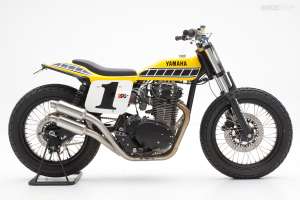
Jeff Palhegyi’s Dirt Tracker
Is there any racing livery more evocative than Yamaha’s classic ‘speed block’ pattern? Put it on a dirt tracker, and you’ve got a match made in heaven. Jeff Palhegyi’s uncompromising XS650, built for the Quail Gathering, has the go to match the show, with a seriously hot-rodded motor nestled in a Mule Motorcycles frame. Jeff’s biggest challenge was how to keep the vibe of the original race bikes while staying road-legal.
He worked with Richard Pollock of Mule Motorcycles for inspiration and secured a frame built by J&M Racing. The stock engine was sent to Mototech USA, where it was given a high-performance makeover with a 750cc big-bore kit and Dell’Orto carbs, pushing this lightweight tracker beyond 65 hp at the rear wheel. A stepped exhaust system, fabricated from Burns Stainless tubing, was critical for both looks and power.
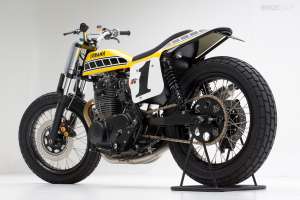
To keep the bike planted, Jeff installed Yamaha YZF-R6 sportbike forks and custom Racetech shocks, with the forks receiving custom-made carbon fiber guards. He black-anodized nearly everything, including the custom foot controls and over 30 one-off billet components, and bead-blasted the engine for a low-key matte look. The low-profile bodywork—a squared-off tank unit from First Klass Glass and a custom-molded tail—is the literal icing on the cake, finished in that iconic Yamaha racing paint. As Jeff admits, “The biggest challenge on this project was hiding all the ‘streetable’ components, and keeping it looking simple,” an achievement he pulled off spectacularly. [MORE]
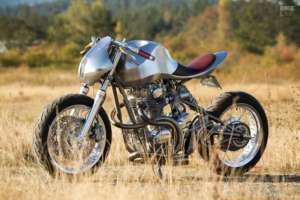
Jay Donovan’s ‘Manta’ Yamaha XS650
We’re always suckers for beautiful metalwork, but seeing both metal artistry and technical upgrades on one build is a rare treat. Built for Michael Lichter’s ‘Motorcycles as Art’ exhibition at Sturgis, this graceful Yamaha XS650, named ‘Manta,’ is the work of Jay Donovan of Baresteel Design. Jay wanted to rework the stock platform so heavily that the final product would seem like it was entirely built from scratch.
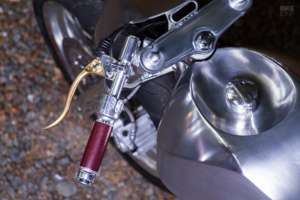
Jay rebuilt most of the rear chassis, ditching the twin-shock setup for a mono shock from a 2008 Ducati Monster. The swingarm was modified to accept a wider rear tire and converted to needle bearings, and the new tail section was set at an angle parallel to the engine fins. The new rear end is matched to a fully polished front with Suzuki SV650 forks and brakes, upgraded with Race Tech internals. The wheels were rebuilt with Excel 17” rims on the stock hubs, wrapped in Dunlop Sportmax high-performance radials.
The crowning glory is the stunning alloy bodywork. The one-piece aluminum tank and tail section, along with the fairing, were all hand-formed from a flat sheet of aluminum using traditional Italian coach building methods. The engine features a top-end rebuild, a Boyer Bransden digital ignition, Mikuni carbs, and a stunning custom-made stainless steel exhaust that snakes around the motor and terminates neatly underneath the bike. From the Motogadget wireless RFID key system to the leather-wrapped grips and kick-start lever, the attention to detail is remarkable, making the ‘Manta’ both a piece of art and a fantastic-looking ride. [MORE]
